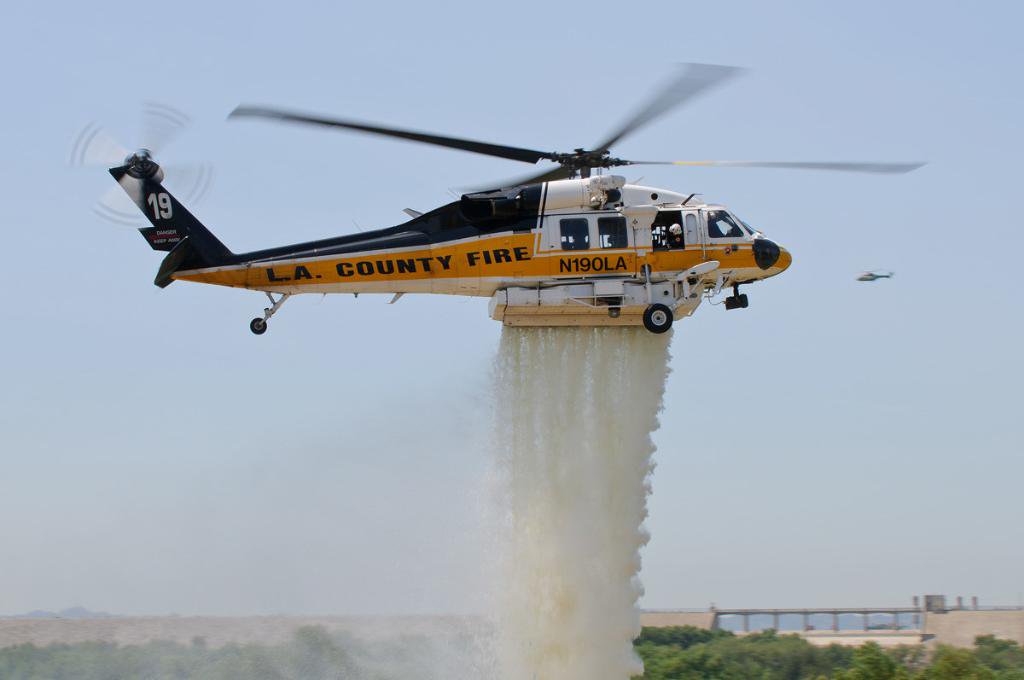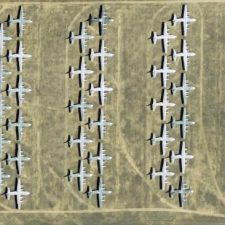Above: C-130’s in the aircraft boneyard at Davis Monthan Air Force Base in Tucson. Google Earth.
(Originally published at 10:19 a.m. MST January 20, 2018)
After hearing rumors that the California Department of Forestry and Fire Protection, CAL FIRE, is considering acquiring C-130’s to use as air tankers, we talked with Dennis Brown, the agency’s Chief of Flight Operations. He confirmed that they are exploring the idea of obtaining some larger air tankers and said the C-130 is on the list of aircraft they are looking at, but emphasized that no decisions have been made. The source of the C-130’s, if that is the direction they choose to go, would be the same as their S-2’s, military surplus, such as the 70+ seen in the photo above in mothballs at Davis Monthan Air Force Base in Tucson.
CAL FIRE has successfully used S-2 air tankers for about 40 years. The aircraft have served the agency well, but since they started acquiring them from the Department of Defense through the U.S. Forest Service in the 1970s the air tanker state of the art has advanced significantly in spite of converting the S-2A and S-2E/G aircraft to modern turboprop engines.

Last year the 1,200-gallon tankers, now known as S-2T’s, worked alongside the 19,000-gallon 747 which holds 15 times more retardant, about the same as three-quarters of CAL FIRE’s entire fleet of 23 S-2t’s.
The agency also had on CWN contract in 2017 a C-130 from Coulson (T-133) and an MD-87 (T-105) from Erickson AeroTanker. A Neptune BAe-146 from Neptune (T-12), was on an exclusive use contract. Those three tankers each have a capacity of at least 3,000 gallons.
Perhaps looking at an S-2T parked on the same ramp as the 747 at Sacramento McClellan Airport last year got people thinking.
Since the reborn 747, which came back in a slightly different configuration after a several-year hiatus, is relatively new to the air tanker world, we asked Mr. Brown how it performed while under a Call When Needed contract with the agency in 2017. He said that in the environments where it was assigned it did very well. Like many aircraft, especially new versions, he said they noticed a few things that needed to be worked on.
For the last several years CAL FIRE has been refurbishing and converting an S-2 into an air tanker to replace Tanker 81 that crashed near Yosemite National Park in 2014, killing pilot Geoffrey “Craig” Hunt. The work is nearly complete on what will become Tanker 79 and they expect to begin flight tests in the next week or two. This will bring the number of S-2T’s in the CAL FIRE fleet back up to their traditional number, 23. The Neptune BAe-146 on contract has temporarily replaced T-81 for the last couple of years.
New CAL FIRE helicopters
As we reported in December, CAL FIRE’s intended contract to purchase up to 12 new firefighting helicopters, Sikorsky S-70i (Firehawks), from Air Methods/United Rotorcraft (AMUR), survived the protest. An administrative law judge ruled against a protest filed by AgustaWestland Philadelphia Corporation (AWPC, part of Leonardo Helicopters) clearing the way for the acquisition.
We asked Mr. Brown how many CAL FIRE intends to purchase, and he said at least one. In a perfect world they would like to buy one a year for 12 years (or possibly more quickly than that) but it is dependant on the helicopters being available at the right times, and more importantly, the state funds.
Los Angeles County Fire Department is acquiring similar helicopters.



Build up three C 130’s starting from the desert? This isn’t going to be no S2 project. How about this; build-up from the desert a C5 Galaxy? Many to chose from (aircraft and parts) last time I looked inside D.M. Stripped out, well below GMTO with 22,000 U.S. gallons of retardant. Power plants you can inspect/service without being an aerial trapeze performer. Flight crews 2, One line aircraft, One maintenance/inspection/logistic and stores (parts) facility/team, at One CENTRAL location MCCC air base, (reload). 6 C130’s 21,000 gallons. One doesn’t want to get too excited about diluting the S2 fleet.
Dave said :”6 C130s operated by CalFire with 2 in the north,2 in central and 2 in southern Ca be smarter?”
answer is yes!
Dave said :”…im trying(sigh) to think about the short turn around times that should be in play for any fire,ya know?”
answer is Yes!
Back up S2’s to build Retardant lines so S2’s can go back to Initial Attack.
+ Tactical spread(network of accessible Reload Bases).
No doubt that several C-130’s with Rads Tanks would really help the State.
ok,im not a pilot,and these questions i have i cant answer myself,and id be wrong anyway…but will they just use McClellan(or whatever the new name is) or will they locate a few C-130s at differant places like maybe Redding ,Castle,and points south?..or would the BAe-146-RJ85 be more suited to some of the longer small airports?.according to wikipedia the BAe-146-200/RJ85 needs 4560′ for T/O and 3900′ for landing in stock configuration,and Grass Valley has a 4351′ runway..so it wont work without adding onto the runway.Lincoln /Karl Harder airport has a 6001′ runway,it might work as a new base?..i know it wouldnt be moved and they wouldnt open a bunch of new ATBs just for a bit larger plane,,and i know the C130 dispersed to places like i mentioned would be smarter….but would (just for argument) 6 C130s operated by CalFire with 2 in the north,2 in central and 2 in southern Ca be smarter?…im trying(sigh) to think about the short turn around times that should be in play for any fire,ya know?
WHAT YOU SAID!! ALSO THE USE OF THE 747 IS LIMITED, CAN NOT BE USED IN STEEP NARROW CANYONS, HOW ABOUT LOW AND SLOW?IE DROP SPEED VS ALTITUDE??? AMONG OTHER THINGS. IN THE LONG AGO, STEERMAN N3N BI PLANES WERE USED. I THINK THEY HELD AROUND 90 GALS. JUST SAYING..
Both the 747 and DC-10 platforms CAN be used in steep canyons and have demonstrated that very conclusively over the years. Both air craft have very large reserves of power even when fully loaded and are doing amazing work in the high country as well as the high deserts.